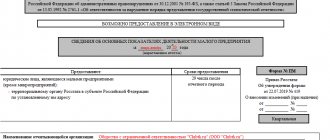Why do you need to count payroll numbers?
As stated above, the value under consideration implies the total number of employees of the enterprise. If we talk about its practical significance, then the payroll number of employees of an enterprise is a test number that helps in solving analytical problems, such as assessing labor efficiency, calculating average wages and staff turnover rates. In addition, the column of the same name is present in a number of reports submitted to regulatory authorities. For example, information on the payroll number of employees is reflected in form 4-FSS, approved by Order of the Social Insurance Fund of the Russian Federation dated September 26, 2016 No. 381. In addition, the specified coefficient is taken as the basis for another value - the average payroll composition of personnel. It, in turn, is necessary when filing tax returns electronically (clause 3 of Article 80 of the Tax Code of the Russian Federation), when calculating income tax at the location of a separate division (clause 2 of Article 288 of the Tax Code of the Russian Federation) or when filling out the DAM form -1 Pension Fund.
The relationship between the payroll and average number of employees
The resulting payroll number, the formula of which was given in this article, allows you to determine the value of the average payroll number (ASCH). In this case, the calculation will be carried out according to the following formula:
- SSCH = Headcount / Number of days in the period.
The use of the average headcount indicator allows companies not only to successfully prepare reports, but also to conduct analytical activities, such as analysis of labor productivity, staff turnover rate, and analysis of the average wage level.
To summarize, we note that determining the size of the payroll does not involve significant labor costs for the accounting department. However, the importance of this indicator cannot be underestimated, because it is not only taken into account when preparing tax and statistical reporting, but also acts as a basis for calculating another analytically significant indicator - the average number of employees.
How to calculate
Calculation of the corresponding coefficient involves the question of who is included in the payroll number of employees. The answer is contained in the Instructions on statistics of the number and wages of workers and employees at enterprises, institutions and organizations, approved by the State Statistics Committee of the USSR on September 17, 1987. According to clause 2.9 of the specified document, the list of employees of the enterprise includes “all employees hired for permanent, seasonal, and also temporary work for a period of one day or more, from the day they are hired.” It should be understood that the number of employees present and on the payroll are different quantities. The latter includes not only employees present at the workplace, but also some of the personnel who did not show up for reasons such as downtime, being on a business trip, illness, annual leave, etc. The full list is determined by clause 77 of the Instructions, approved by order of Rosstat dated 22.11. .2017 No. 772.
Calculation of the number of employees
Currently, several methods have been developed with which you can carry out the necessary calculations of the staffing level of your employees. But there are methods that are more common than others; they are successfully used by most companies and organizations.
Calculating the number of employees, which is based on the concepts of labor standards, seems to be the most promising and effective. With this method, it is necessary to carefully record employee absences for various reasons, including valid ones, which ultimately must correspond to the approved plan. All these calculations are included in the annual and quarterly financial statements.
At the same time, we should not forget that every enterprise, no matter how small it may be, has the legal right to independently develop standards and adopt methodological recommendations for the number of employees. In the future, it can adhere to them when making calculations for as long as desired.
Who is excluded from the calculation
As stated above, the payroll includes employees who have entered into labor relations with the enterprise, regardless of their nature and duration. In accordance with paragraph 79 of the Rosstat Instructions mentioned above, the following employees are not included in the payroll:
- hired externally;
- working under civil contracts;
- enterprises working under special agreements with government services to attract labor (military personnel and persons serving sentences);
- transferred to work in another organization;
- aimed at training without work and without pay;
- those who submitted a letter of resignation and stopped working before the expiration of the warning period or stopped working without warning;
- lawyers;
- military personnel in the performance of military service duties.
Let's consider the scheme for calculating the average number of employees for the most common cases:
| Employee type | Accounting in the payroll | Accounting in the average headcount | Example |
| Key full-time employee | Whole units | (1*n)/m n is the number of calendar days worked by the employee in a month; m — number of calendar days of the month | The employee will resign effective June 20. He is included in the payroll as of June 30 as 0 (since as of June 30 he is no longer working in the organization). Additional InformationOften the employer does not know whether to include the employee in the list or not. There are some workers about whom particularly strong doubts arise:
FOR YOUR INFORMATION! Employees engaged in seasonal work usually work on the basis of a civil contract, that is, they will also not be included in the list. Free legal advice: |
What are the differences from the average
As we previously found out, the number of employees on the payroll is the number of people who have entered into an employment relationship with the organization in the form of an employment contract. This value is calculated for each day in whole units and corresponds to the number of people declared on the working time sheet. The resulting indicator is taken as the basis for calculating the average headcount, a significant value for statistics and taxation. Its calculation for a month is carried out as a calculation of the average value: the average value for each calendar day is summed up, the resulting amount is divided by the number of calendar days. The quarterly coefficient is calculated in a similar way. However, in order to obtain correct data when calculating both quantities, it is necessary to take into account a number of nuances.
Mandatory reporting
Information on the number of employees must be submitted by legal entities of all forms of ownership and individual entrepreneurs. Individual entrepreneurs provide calculations to the tax authorities if they have full-time specialists (or had them in the reporting period).
This is stipulated in paragraph 3 of Article 80 of the Tax Code of the Russian Federation. Legal entities submit data regardless of the presence or absence of employees, changes in their number compared to last year. This is a mandatory condition and applies to all legal entities, regardless of their form of ownership and tax regime.
Why is this information needed?
The Federal Tax Service inspectorates use this information to monitor the method of filing returns and the grounds for using a special tax regime. There are restrictions on the methods of filing declarations:
- electronic version through the EDI operator - for legal entities with a staff of over 100 people;
- electronic or paper to choose from – for taxpayers with a staff of less than 100 people.
As for special regimes, a simplified system is allowed to taxpayers if the staff does not exceed 100 people. A maximum of 15 employees are allowed to work on the patent system.
Form
The information is filled out and submitted on a form consisting of one sheet (form according to KND 1110018). It states:
- TIN;
- Company name;
- FULL NAME. entrepreneur;
- the inspection office to which the form is submitted;
- annual number;
- dates (January 1 or 1st of the month).
The accuracy and completeness of the information provided is confirmed by the signature of the entrepreneur, head of the company or authorized person, or seal. Data for the enterprise as a whole is entered into the appropriate columns - there is no need to make separate calculations for branches and separate divisions.
Deadlines
The report on the average number of employees for 2019 is due no later than January 20, 2020, and for 2020 – no later than January 20, 2021. The deadline for submitting it to the Federal Tax Service is determined in paragraph 3 of Art. 80 of the Tax Code of the Russian Federation.
If the deadline date coincides with a weekend, the deadline is postponed by one day. The date shift is provided for in paragraph 7 of Art. 6.1. Tax Code. If a new enterprise is registered, then responsible employees must submit data on the number of employees no later than the 20th day of the next month.
For violation of reporting deadlines, the company faces penalties under Art. 126 of the Tax Code of the Russian Federation. 20 days are allotted for compiling lists of violators, after which a notification of a fine is sent.
Tax authorities have the right to fine responsible officials of violating companies. The administrative measure is provided for in Art. 15.6 Code of Administrative Offenses of Russia. The amount of sanctions is up to 500 rubles.
Where do maternity leave belong?
It was demonstrated above that the procedure for calculating the quantitative characteristics of personnel is quite simple. Confusion arises, as a rule, due to the existence among the staff of those who are included in the number of employees on the payroll, but are not included in the average payroll. This applies, for example, to such a category as women (in some cases men) on parental leave. Are maternity leavers included in the payroll? An affirmative answer to this question is given by clause 77 of the Rosstat Instructions (approved by Rosstat Order No. 772 dated November 22, 2017). However, clause 79.1 of the same document states that this category of workers is not included in the average. The rule also applies to persons studying or entering an educational institution while on leave without pay.
Which employees are included in the list?
The list includes these specialists:
- Employees who actually reported to the place of duty.
- People who are on business trips. If the business trip is foreign, then inclusion in the list depends on the duration of the event. If it is short-term, the employee is included in the list. If the business trip is long-term, then the employee is not included in the list.
- Persons who are absent from the workplace on sick leave.
- Persons performing public or government functions.
- Persons who work part-time but are enrolled as a whole unit.
- Persons working from home.
- Those on probation.
- Temporary employees who replace the main ones until the latter return to work.
- Employees sent on vacation.
- Persons undergoing training at a vocational school, but who are registered with the company.
- Persons temporarily involved in agricultural work, if earnings from their main job are maintained.
- Employees working on a rotational basis.
- Women who went on leave due to BiR.
- Those who have reached retirement age.
- Foreign persons employed in a Russian company.
- Persons under investigation awaiting a court decision.
IMPORTANT! All of the above categories of employees are included in the list from the date the employment contract comes into force. If workers carry out their activities without an agreement at all, they will not appear on the lists.
FOR YOUR INFORMATION! There is also such a thing as turnout numbers. It represents the number of employees who reported to work on a given day. This list also includes those employees who are on business trips.
Nuances and difficulties
In addition to persons on maternity leave, there are other categories of employees that cause controversy when calculating staff numbers. For example, the question often arises whether the owners of the enterprise are included in the SC. According to paragraph 77 of the Rosstat Instructions (approved by Rosstat Order No. 772 dated November 22, 2017), the answer to this question is affirmative, provided that the owners worked and received wages. Paragraph 78 of the document also contains commentary regarding internal part-time workers. Each of them is counted as one person in the account balance. As for persons who have an employment contract and a work contract with the organization at the same time, they, in accordance with paragraph 78 of the Instructions, are taken into account in the SCH and SSC once at their main place of work.
Reporting on the number of employees
Often at enterprises, management requires official documentary records of the number of employees. For this purpose, list data is compiled, which takes into account standards for determining the size of the company's staff.
The data entered in these lists must correspond to the number of employees included in the timesheet. This way you can record attendance effectively and without unnecessary labor costs.
Also, do not forget that when determining the number of employees, the recommendations developed by the labor inspectorate must be followed. After all, the correctness of your calculations will directly depend on this.




